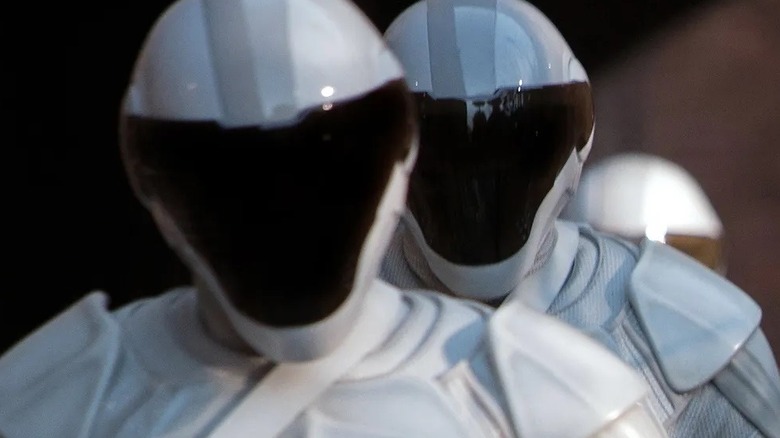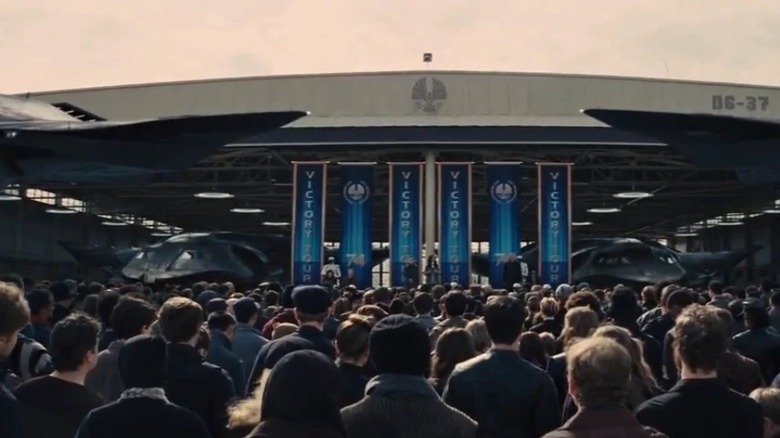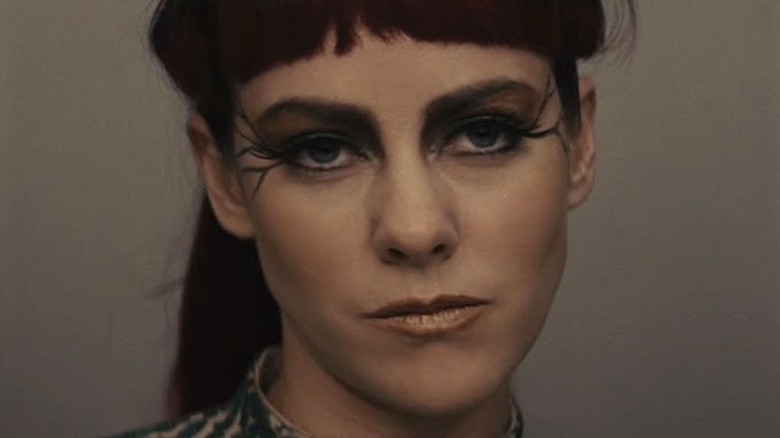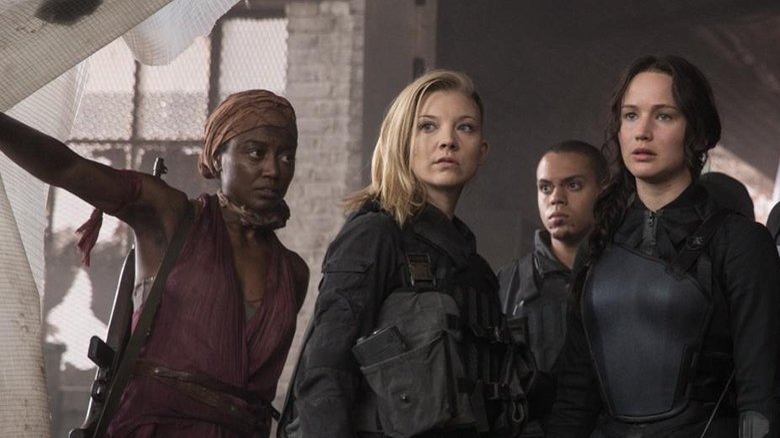Every District From The Hunger Games Explained
"The Hunger Games" is one of the most well-known dystopian series of the 21st century. The soon-to-be five-part film franchise is based on a series of four books that give readers a glimpse into a North America broken into several districts, ruled by a city that is massively more well-off than the rest of the nation. A decade after the original film came out, it seems only fitting that fans are returning to Panem soon with the film adaptation of the prequel novel "The Ballad of Songbirds and Snakes."
Fans may know how many districts make up the country, or even the popular tributes that represent them, but understanding the commodities each one provides the Capitol takes a bit more effort. While some like District 12 are explicitly stated, others like District 6 require a magnifying glass to find. Of course, there's more to the districts than growing crops and mining coal — there's much more lurking beneath the surface, literally. Let's break down what you need to know about every district before Panem returns to screens, just in case you need to know which district will have your back during a rebellion.
The Capitol
Though not a district by name, the Capitol leads the 12 (formerly 13) districts, and it's important to know about the place and its people to understand the history of Panem. The Capitol is filled with the elite members of the country who support their dictator wholeheartedly. They function solely because of the districts. All of their power, food, and supplies come from the work of citizens outside the city. If they rebel, that precious structure would be rocked to the core, causing famine, disease, and destruction.
The Capitol is also responsible for the Hunger Games, as readers learn in the opening chapter of the first book. After the First Rebellion (also referred to as the Dark Days), in which several districts rose up against the Capitol, the ruling city enacted the Games as a reminder that nothing like that rebellion can happen again. The continued occurrence of the Games forever keeps the districts under the Capitol's power. If a poor family needs to take out tesserae, or rations, to make ends meet, it's the child that takes it out in exchange for additional cumulative entries in the tribute drawing. The Capitol celebrates the Games, having parties and parades, while the districts watch and hope their tributes aren't killed right away.
After the Second Rebellion comes to a close in "Mockingjay," the government in the Capitol transitions from a dictatorship to a constitutional republic. The Hunger Games are disbanded, though a final Games is suggested that pits Capitol children, rather than those of the districts, against each other.
District 1
District 1 has one of the best relationships with the Capitol of any district due to what they produce. As we learn in the first book, all the luxury goods, like jewelry and fancy baubles, that the Capitol hoards are created and manufactured in this district. In "The Hunger Games," Katniss describes what she's heard about them, including rumors of a machine capable of turning graphite into diamonds. Where the graphite is coming from is anyone's guess, since the district that mined graphite was bombed out of existence during the Dark Days.
Don't let this positive-sounding relationship fool you, though; District 1 is required to compete in the Hunger Games just like the others. However, they train their children for success in the Games. District 1 tributes tend to do well with that leg up, proving particularly popular with the spectators of the Capitol, based on the cheers the district receives during the opening ceremonies. Their tributes are called "Careers" due to this intense preparation and excitement. Technically, tributes aren't supposed to train before reaching the Capitol, but everyone knows District 1 doesn't follow that rule. It suits the Capitol's amusement, so it isn't enforced.
However, their tributes haven't always been excited to enter the arena. During the 10th Games, as seen in "The Ballad of Songbirds and Snakes," the representatives of District 1 make an escape attempt that costs them their lives before the Games even begin.
District 2
District 2 is the masonry district, providing building materials, but that isn't the only thing they supply the Capitol with. While it isn't widely known by the other districts, District 2 is where weaponry is created and manufactured, as revealed in "Mockingjay." It's also the district where Peacekeepers, the infantry controlled by the Capitol and deployed to districts when necessary, are trained and recruited. The district is home to the Nut, an underground military base that was established in old mines after the First Rebellion. It makes sense to have the military base where the weapons and manpower come from.
Katniss notes that District 2's male tribute, Cato, during her first Hunger Games (the 74th annual) is "monstrous." He volunteered during District 2's reaping and makes no effort to hide his brute strength at the Training Center. Like District 1, their children are trained for the Games, and the Capitol is okay with that, making them members of the Careers in the arena. None of this is surprising, considering the career paths ahead of the district's residents. Katniss also describes Cato as a "ruthless killing machine," which may come from training for the dictatorship's military.
District 3
With luxuries, stone materials for construction, and the military accounted for, the next thing the Capitol needs is technology. As we learn in the first book, District 3 has factories that allow for the manufacture of televisions, cars, and anything else that uses wires. That also includes explosives. Their industrial identity is further solidified in "The Ballad of Songbirds and Snakes," when their tributes are referred to as the "tech district tributes."
While District 3 doesn't train their children for the Games the same way Districts 1 and 2 do, they clearly are encouraged to learn about the district's industry before reaching adulthood. During the 74th Hunger Games, the male tribute from the district reactivates the land mines used to keep tributes on their platforms before the Game-starting gong goes off. It takes a particular set of skills to know how to do that without hurting yourself, and there is no other district that would have the access or resources to learn them.
District 3 returning victor Beetee is crucial to the escape plan that happens during the 75th Games in "Catching Fire," which really puts the Second Rebellion into motion. Using special wire he invented and the arena's mechanics against itself, he plans to make a hole in the forcefield surrounding the arena. While Katniss ends up finishing his plan for him, it's the skills and technology he developed in District 3 that made it possible.
District 4
The Districts we've covered so far provide material goods, but the Capitol needs to eat. District 4 helps with that, as it's revealed early in the first book that their main industry is fishing. They procure not only seafood, but the vegetation under the water too, as described by the bread flavored with seaweed that Peeta and Katniss eat during their first Games.
As a major food supply, District 4's revolt has an immediate impact on the Capitol. In "Catching Fire," it's revealed the Capitol residents haven't had access to shrimp in several weeks because of inclement weather — at least, that's what they're being told. It's actually because rebellion in District 4 has already begun, starting just after the 74th Hunger Games (at least, that's what Katniss suspects based on her memory of the Victory Tour).
Their tributes are the final members of the Careers. Not only skilled with fishing equipment like tridents that can be used to wreak havoc in the Games, children from the district can also tie various knots and weave nets from anything, adding to their deadly toolbox. In fact, that's how Finnick Odair (Sam Claflin), one of the youngest victors of the Games, wins. At just 14 years old, he makes nets from vines, capturing the other tributes before killing them with a trident.
District 5
With an entire district dedicated to technology, the Capitol needs electricity to use what District 3 makes for them. While it is never explicitly stated in the original books what the fifth district's industry is, it's hinted at in the prequel "The Ballad of Songbirds and Snakes." During the First Rebellion, the Capitol has issues with its power grid, which are blamed on rebel interference in District 5.
While this isn't confirmation of exactly what the district does, later on in the book as a tour of the district's industries is given during a telecast before the Games, the host gives a "spiel on energy" when talking about District 5. This confirms that their industry has to do with power, likely electricity. The fourth film, "The Hunger Games: Mockingjay – Part 2," also includes imagery of a hydroelectric dam in the district.
The district played an important role in the Dark Days, as the Capitol's power grid problems caused air raid sirens to be unreliable, meaning the residents could not seek shelter in the event bombs were dropped on the city. In being the source of their electricity, District 5 could also cut off the supply that protected them.
District 6
Figuring out District 6's industry is a little tricky. It's never said outright in the original novel trilogy or the prequel, but it is mentioned in books that were published alongside the film adaptations. "The Hunger Games: Tribute Guide" describes District 6 as the makers of the trains and hovercrafts used in the series. This is confirmed in "district ads" created as part of the promotional campaign for the movie version of "Catching Fire." With all the trains used to bring tributes to the Capitol after the reapings, and the hovercrafts used to travel and remove the deceased from the Games, it's no wonder there's a district with a focus on transportation.
It's implied from Katniss' interactions with the District 6 tributes during the 75th Games that addiction, specifically to the painkiller morphling, is an issue with the district's residents. One of the most well-known tributes, Titus, is from District 6. Titus tries to eat the tributes he's killed — something that hadn't been seen before in the history of the Games. While the Capitol loves an exciting competition, cannibalism is not what they have in mind. An avalanche kills Titus, though Katniss notes there's speculation it was "specifically engineered to ensure the victor was not a lunatic."
District 7
District 7 provides lumber and paper products for Panem. The country never forgets it, either, because during the opening ceremonies the district's tributes are almost always dressed as trees (at least according to victor Johanna Mason in "Catching Fire"). Investors in the Capitol have money riding on the industry. An investment in lumber is considered old money in the city, and as we learn in "The Ballad of Songbirds and Snakes," families who invested in it bounced back nicely after the First Rebellion.
While the children of District 7 aren't trained the same way the Careers are, they do have skills that benefit them in the Games. Their tributes can throw around axes and other deadly implements easily. Katniss speculates in "Catching Fire" that this is because they're exposed to their district's industry at a young age. Still, that isn't always how they succeed in the arena. Johanna makes it to the end of her first Games by pretending to be cowardly and weak. "It turned out she could kill viciously," Katniss explains in "Catching Fire." "Pretty clever, the way she played it."
District 8
District 8's industry is first revealed in "Catching Fire," when Katniss sees a video not meant for her eyes. It describes the mobs and riots happening in the district after the 74th Games, and says that textile production has come to a halt. She receives confirmation of what District 8 manufactures when two runaways, Bonnie and Twill, stumble into the outskirts of District 12. They're wearing Peacekeeper uniforms, but it's clear they aren't part of the military. "I stole them from the factory," Bonnie confirms. "We make them there."
Their uprising begins during the Victory Tour, when Peeta and Katniss' interview with Caesar Flickerman is aired in all the districts, providing an excuse for everyone to be in the town square. The lack of textile production impacts the Capitol, with Katniss' glam team complaining they haven't had access to specific fabrics and ribbons while they ready her for a bridal shoot.
Their tributes have mixed success in the Games, based on what we learn in the trilogy and prequel. Bobbin, the male tribute in the 10th Games, told his mentor about "five different ways he could kill someone with a sewing needle," but it didn't seem to help him when the time came. He's killed when two mentors enter the arena to remove a body, while the District 8 tributes in the 74th and 75th Games die on day one.
District 9
A food supply is nothing without the largest part of the food pyramid: grains. District 9 grows all of the grain needed by the Capitol, and maybe whatever is sent to the districts as part of their tesserae. The district's industry is never outright stated in the original trilogy, though there are mentions of fields of wheat while Katniss and Peeta are on their Victory Tour in "Catching Fire." What they provide for Panem is confirmed in "district ads" created as part of the promotional materials for the "Catching Fire" movie.
Of the tributes who represent District 9 in the books, none of them make it particularly far in the Games. During the 10th Games seen in "The Ballad of Songbirds and Snakes," Panlo and Sheaf, the male and female tributes of the district respectively, die from injuries as a result of bombings in the Capitol before the Games. Before her death, Sheaf tries to entertain the Capitol people as thanks for food. During the 74th and 75th Games, District 9's tributes die during the first day in the arena. That isn't to say their tributes regularly do poorly; they do have representatives present during the 75th Games, when the tributes have to be previous victors.
District 10
Fish aren't the only animals the districts provide as part of the food supply — District 10 raises livestock. Katniss refers to their tributes as "livestock keepers" in "Catching Fire," noting they're dressed as cows for the opening ceremonies. The prequel confirms the district's industry when one of their tributes is mentioned as having a lengthy discussion on slaughterhouse techniques during an interview. A refugee from District 10, Dalton, escapes and defects to another district before the 74th Games. He's described as a "cattle expert" throughout "Mockingjay," confirming that cattle was one of the animals raised by the district.
During the festivities leading up to the 10th Games, the female tribute for the district, Brandy, kills her mentor. At this point in Panem's history, tributes are treated differently, being kept in monkey cages in a zoo. Her mentor mocks her with food, until Brandy takes matters into her own hands. The tribute is punished for her actions, and she never makes it to the arena. She's the first of several tributes to be reaped without ever participating in the Games that year.
District 11
Grains aren't the only crops grown for Panem. The first book explains that District 11's focus is on agriculture, growing fruits and vegetables for the country. Though they grow the food, they aren't allowed to eat it — if they do, corporal punishment follows. "Oh, no, we're not allowed to eat the crops," Rue tells Katniss during the 74th Games. "They whip you and make everyone else watch." While on a tour after the Games in "Catching Fire," Katniss notes the watchtowers in the fields filled with Peacekeepers, and how they don't look like they belong among the crops.
Tributes from District 11 are better off than others when it comes to Game preparation. Children help pick fruits in the tall trees, giving them practice climbing and balancing. They may also help with other crops in the fields, giving them strength and practice yielding tools that could be used as weapons in the arena.
District 11 shows signs of rebellion during the Victory Tour in "Catching Fire." After Katniss' kind words about their tributes, an older man whistles the tune Rue taught her in the arena, causing the entire crowd to use the three-fingered salute. The man is killed for his actions. An uprising begins in District 11 during the events of "Mockingjay," with the rebels eventually taking control of the district.
District 12
One of the poorest districts of Panem, District 12 works to mine coal for the country in the Appalachian Mountains. As we learn in the first book, many families suffered losses from mining accidents, including the Everdeens. These accidents would make it difficult for families to provide for themselves, as children did not help with mining until they turned 18. "The Ballad of Songbirds and Snakes" reveals that if the adults don't mine enough coal, Peacekeepers are sent to increase production. The district does not have aspects of life many are used to, like electricity or a stable food supply. "We're lucky to get two or three hours of electricity in the evenings," Katniss explains in the first chapter of the series.
Due to their quality of life, tributes from the district tend not to do well in the arena. Snow describes them as "stunted" and "joint-swollen" in Chapter 2 of the prequel. District 12 boasts four winners over 75 years: Lucy Gray Baird, Haymitch Abernathy, Katniss Everdeen, and Peeta Mellark. They are the only district to have two winners from the same Games. This unique occurrence serves as a catalyst for the Second Rebellion, and after the events of the 75th Games, District 12 is bombed. Those who are evacuated or survive are rescued by another district. After the Second Rebellion, District 12 begins to rebuild, their industry shifting from coal to medicine, with new factories built in the district just for that purpose.
District 13
District 13 is one of the original districts of Panem, but becomes its own entity after the First Rebellion, never participating in the Games. They're known for their graphite mining, but like District 2, "Catching Fire" reveals they have a secret industry: nuclear development. "They had a few small mines, yes," District 8 refugee Twill explains to Katniss. "But not enough to justify a population of that size."
The country is told the district has been made an example of to prevent further rebellions. Families like President Coriolanus Snow's who hold investments in the district lose everything after the surface is bombed, as seen in "The Ballad of Songbirds and Snakes." Its residents remain there, though, still working toward their cause. As explained in "Mockingjay," after gaining control of the defense systems, the district convinces the Capitol to let them "play dead in exchange for being left alone." They move into underground bunkers white the Capitol bombs the buildings, and the other districts are told the same will happen to them if they misbehave.
District 13 struggles with many issues over the 75 years between the Dark Days to the Second Rebellion. A pox epidemic takes out quite a bit of the population, but they rebuild with refugees from other districts and the survivors of District 12. The Capitol still keeps tabs on them, however, sending reporters out to document the surface.














